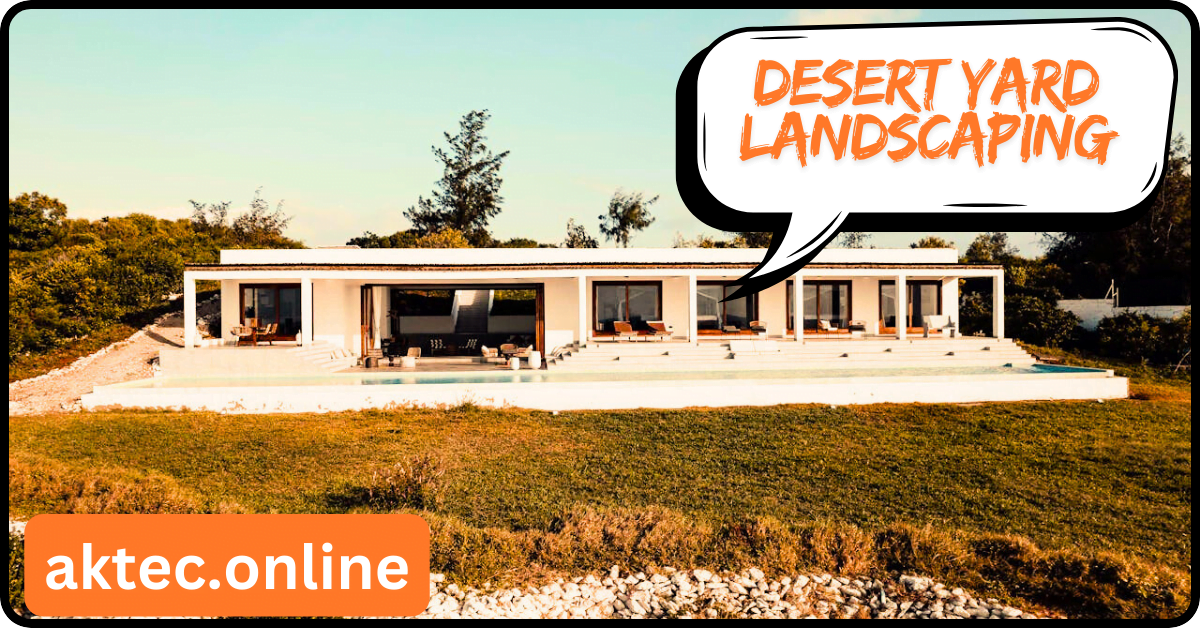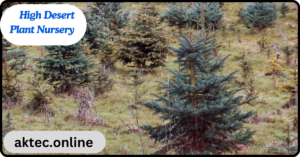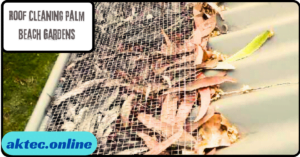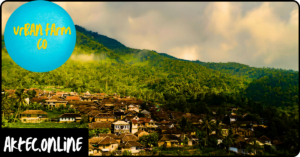
Unleash the beauty of your desert yard. Our guide to desert yard landscaping reveals drought-resistant plants, water-saving tips and stunning design ideas.
Desert Yard Landscaping: Transforming Your Arid Oasis
Desert yard landscaping isn’t just about cacti and sand. It’s about creating a beautiful, functional outdoor space that thrives in the unique challenges of a desert environment. Desert yard landscaping allows you to cultivate a vibrant and sustainable haven while conserving precious water resources.
Why Landscape a Desert Yard?
Traditional landscaping practices often clash with the hot, dry reality of desert climates. However, desert yard landscaping offers a multitude of benefits:
Reduced Water Usage
Water conservation is paramount in deserts. Desert yard landscaping utilizes drought-tolerant plants and efficient irrigation methods to minimize water waste.
Year-Round Beauty
Desert landscapes boast a stunning palette of colors and textures, with plants that flourish in the arid conditions.
Low Maintenance
Desert-friendly plants require less frequent watering, weeding, and fertilization compared to traditional gardens.
Increased Property Value
A well-designed desert yard not only enhances curb appeal but also adds value to your property.
Understanding the Desert Environment
Desert Climates: Hot and Dry
Desert environments are characterized by scorching temperatures, limited rainfall, and intense sunlight. These factors pose significant challenges for traditional landscaping practices.
Challenges and Water Conservation
Desert landscapes face the hurdle of limited water availability. Desert yard landscaping addresses this by:
Selecting plants that require minimal watering.
Implementing efficient irrigation systems like drip irrigation that deliver water directly to plant roots.
Utilizing mulch to retain moisture in the soil.
Designing Your Desert Oasis
Plant Selection
Drought-Resistant Champions
The cornerstone of successful desert yard landscaping is choosing drought-resistant plants. Here are some popular choices:
Cacti: A classic desert staple, cacti come in a variety of shapes, sizes, and flowering varieties.
Succulents: These water-storing plants offer vibrant colors and low-maintenance appeal.
Ornamental Grasses: Provide movement and texture with minimal water needs.
Native Plants: Adapted to the local climate, native plants thrive with minimal intervention.
Hardscaping for Beauty and Function
Hardscaping elements like rocks, gravel, and pavers not only add visual interest but also help conserve water:
Reduced Evaporation
Gravel and rocks minimize soil surface area, reducing water evaporation.
Directed Drainage
Paving channels rainwater towards designated areas, preventing runoff and promoting efficient water utilization.
Embrace Native Plants for Sustainability
Native plants are perfectly adapted to your specific desert environment. They require minimal water, attract beneficial pollinators, and promote a healthy desert ecosystem.
Maintaining Your Desert Paradise
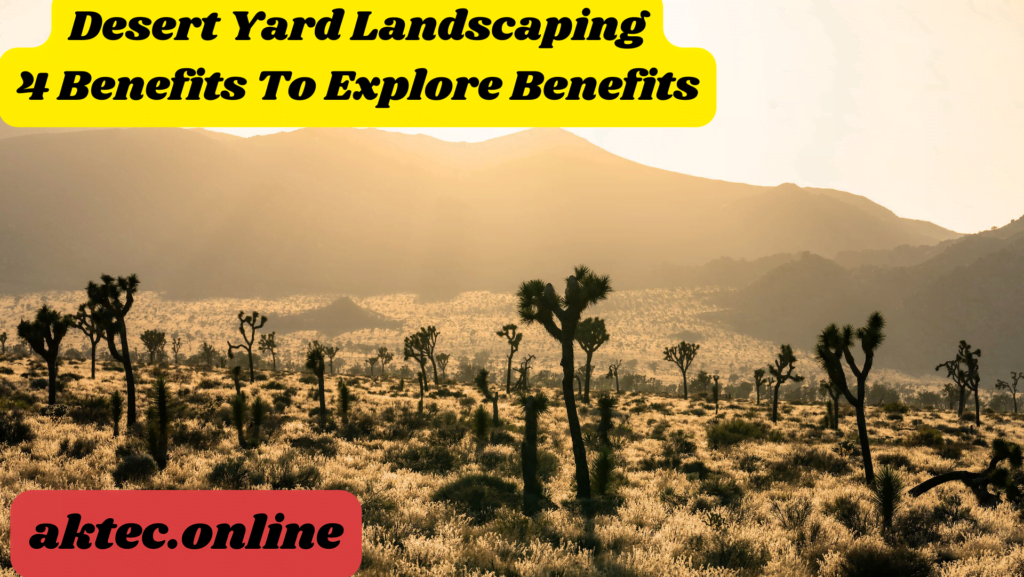
Watering Wisely
Efficient irrigation is crucial for desert landscapes. Utilize drip irrigation systems to deliver water directly to plant roots, minimizing evaporation. Water deeply and infrequently, allowing the soil to dry completely between watering.
Soil Management and Arid Fertilization
Desert soils tend to be sandy and lack nutrients. Amend your soil with organic matter like compost to improve water retention and provide slow-release nutrients for your plants. Since desert plants are adapted to low-nutrient environments, avoid over-fertilization.
Pruning and Pest Control
Regular pruning encourages healthy growth and maintains the desired shape of your plants. Desert environments tend to have fewer pest problems compared to more humid regions. However, monitor your plants for signs of insect damage and treat them organically whenever possible.
Sustainable Practices for a Thriving Desert Yard
Sustainable Landscaping: A Desert Necessity
Desert yard landscaping goes beyond just water conservation. Here are some additional practices to consider:
Renewable Resources
Utilize solar lighting and low-flow water features to minimize your environmental impact.
Promoting Biodiversity
Plant a variety of native plants that attract pollinators like butterflies and bees, fostering a healthy ecosystem.
Showcasing Success: Inspiration for Your Desert Yard
Case Studies: From Dream to Reality
Get inspired by real-world examples of successful desert yard landscaping projects. Look for online galleries and case studies showcasing desert yards transformed into vibrant oases.
Testimonials: Homeowners and Landscape Professionals
Read testimonials from homeowners who have embraced desert yard landscaping and hear from landscape professionals offering expert advice.
Before and After Transformations: Witness the Power of Design
Visualize the potential of your own desert yard. Explore “before and after” pictures to see the dramatic transformations possible through thoughtful desert yard landscaping.
Beyond Beauty: The Ecological Benefits of Desert Yard Landscaping
While the aesthetic appeal of a desert oasis is undeniable, the ecological benefits of desert yard landscaping extend far beyond creating a visually stunning outdoor space. Here’s how your desert yard can become a haven for the desert ecosystem:
Supporting Pollinators
By incorporating a variety of flowering native plants, you provide a vital food source for pollinators like butterflies, bees, and hummingbirds. These creatures play a crucial role in plant reproduction, ensuring the health and diversity of the desert ecosystem.
Habitat Creation
Desert landscapes often lack the natural vegetation needed by birds, small mammals, and reptiles. Desert yard landscaping can provide much-needed shelter and nesting sites for these animals. Consider adding rock piles, birdhouses, and bat boxes to further enhance the habitat value of your yard.
Erosion Control
Desert soils are particularly vulnerable to wind and water erosion. Native plants with deep root systems help to anchor the soil, preventing erosion and promoting soil health. This reduces dust storms and maintains the delicate balance of the desert ecosystem.
Reduced Light Pollution
Strategically placed trees and shrubs can help to block unwanted light pollution from streetlights and neighboring properties. This creates a darker nighttime environment, which is beneficial for nocturnal desert creatures and promotes a more natural night sky for stargazing.
Embracing Water-Wise Features
Beyond Irrigation: Exploring Water Conservation Strategies
While efficient irrigation is crucial, desert yard landscaping encourages exploring additional water-wise features:
Rainwater Harvesting
Capture precious rainwater using rain barrels or cisterns. This collected water can then be used for watering plants, reducing your reliance on municipal water sources.
Graywater Systems
Graywater refers to used water from sinks, showers, and washing machines (excluding toilets). With proper filtration, graywater can be used to irrigate your desert landscape, further reducing your reliance on potable water. (Note: Check local regulations regarding graywater use before implementing such a system.)
Water-Efficient Features
Consider installing low-flow water features like fountains or birdbaths. These features can add a touch of tranquility to your desert oasis while minimizing water usage.
Unleashing Your Creativity: Design Ideas for Every Desert Yard
From Small Patios to Grand Estates: Desert Yard Design Inspiration
Desert yard landscaping is not limited to sprawling estates. Here are some design ideas to suit any desert yard size:
Small Patios:
Create a vibrant vertical garden using container plants and hanging baskets. Utilize colorful gravel and strategically placed rocks to add visual interest.
Mid-Sized Yards
Incorporate a combination of drought-tolerant plants, walking paths made from decomposed granite, and a small water feature for a touch of serenity.
Large Estates
Designate separate areas for relaxation, entertainment, and wildlife habitat. Utilize a variety of native plants, create dry creek beds for natural drainage, and incorporate desert-friendly hardscaping elements like patios and walkways.
The Future of Desert Yard Landscaping: Innovation and Sustainability
The future of desert yard landscaping is brimming with innovation and a continued focus on sustainability. Here are some exciting trends to watch:
Xeriscaping Goes High-Tech
Smart irrigation systems with soil moisture sensors will further optimize water usage, automatically adjusting watering schedules based on real-time conditions.
Drought-Tolerant Turf grass
New advancements in drought-tolerant turf grass varieties promise a low-water alternative to traditional lawns, perfect for desert yards with play areas.
Desert-Friendly Pools and Water Features
Evaporative cooling systems and innovative pool covers will minimize water loss from desert pools and water features, allowing for a refreshing element without sacrificing water conservation efforts.
Water Harvesting Techniques
Rainwater harvesting systems will capture precious rainwater, providing a supplemental source for irrigation and promoting water self-sufficiency.
Vertical Gardens
These space-saving gardens utilize vertical walls, maximizing plant life in smaller desert yards and offering a unique aesthetic.
By embracing these advancements and fostering a commitment to sustainable practices, desert yard landscaping will continue to transform arid landscapes into beautiful, water-wise havens for generations to come.
Ready to Transform Your Desert Yard?
Desert yard landscaping doesn’t have to be a daunting task. With careful planning, plant selection, and sustainable practices, you can create a stunning and low-maintenance outdoor space that thrives in the desert environment.
Here are some resources to get you started:
Your local Cooperative Extension Service: https://www.nifa.usda.gov/about-nifa/how-we-work/extension/cooperative-extension-system offers valuable resources and guidance on desert landscaping specific to your region.
Desert-friendly plant nurseries: Look for nurseries specializing in drought-resistant plants native to your desert climate.
Online resources and landscaping forums: Connect with other desert homeowners and landscaping professionals for inspiration, advice, and troubleshooting tips.
With a little planning and creativity, you can transform your desert yard into a beautiful and sustainable oasis, a testament to the harmony between human design and the remarkable desert environment.
Desert Yard Landscaping: Cultivate a Thriving Oasis in the Arid Aridity
Embrace the captivating beauty of your desert yard with desert yard landscaping, a sustainable approach that transforms parched landscapes into vibrant oases. Desert yard landscaping goes beyond cacti and scorching sand. It’s about creating a functional and aesthetically pleasing outdoor space that thrives in the unique challenges of a desert environment.
Unveiling the Benefits of a Desert Oasis
Forget about endless hours spent watering a thirsty lawn. Desert yard landscaping offers a plethora of benefits:
Reduced Water Usage
Water conservation is paramount in desert regions. This approach utilizes drought-tolerant plants and efficient irrigation methods to minimize water waste, making it an environmentally friendly choice.
Year-Round Beauty
Desert landscapes boast a stunning palette of colors and textures, with a variety of plants that flourish in the arid conditions. Imagine vibrant cacti blooms, cascading succulents, and ornamental grasses swaying in the desert breeze.
Low-Maintenance Marvel
Say goodbye to relentless weeding and frequent watering. Desert-friendly plants require minimal maintenance, freeing up your precious time for enjoying your outdoor haven.
Increased Property Value
A well-designed desert yard not only enhances curb appeal but also adds value to your property, making it a smart investment.
Understanding the Desert’s Embrace
Desert Climates: Hot and Dry
Desert environments are characterized by scorching temperatures, limited rainfall, and intense sunlight. These factors pose significant challenges for traditional landscaping practices. Understanding these unique conditions is the first step to creating a thriving desert yard.
Challenges and Water Conservation Strategies
Limited water availability is a primary concern in desert landscapes. Desert yard landscaping tackles this challenge through several strategies
Drought-Resistant Plant Selection
Choosing plants that require minimal watering is crucial. Cacti, succulents, ornamental grasses, and native plants are all excellent choices for a desert yard.
Efficient Irrigation Systems
Ditch the wasteful sprinkler system. Drip irrigation delivers water directly to plant roots, minimizing evaporation and maximizing water efficiency.
Mulch Magic
A layer of mulch around your plants helps retain moisture in the soil, reducing the need for frequent watering.
Designing Your Desert Paradise
Plant Power: Drought-Resistant Champions
The cornerstone of successful desert yard landscaping is choosing the right plants. Here are some popular drought-resistant options to consider:
Cacti
These iconic desert dwellers come in a variety of shapes, sizes, and flowering varieties, adding a touch of the unexpected to your landscape.
Succulents
These water-storing plants offer vibrant colors and require minimal maintenance, perfect for busy homeowners.
Ornamental Grasses
Provide movement and texture with minimal water needs. Choose from feathery plumes to wispy stalks for a touch of elegance.
Native Plants
Perfectly adapted to the local climate, native plants thrive with minimal intervention. They require less water and attract beneficial pollinators, promoting a healthy desert ecosystem.
Hardscaping for Beauty and Functionality
Hardscaping elements like rocks, gravel, and pavers not only add visual interest but also play a crucial role in water conservation:
Reduced Evaporation
Gravel and rocks minimize soil surface area, reducing water evaporation from the soil.
Directed Drainage
Paving channels rainwater towards designated areas, preventing runoff and promoting efficient water utilization.
Defining Space
Create pathways, patios, or seating areas with pavers, adding structure and functionality to your desert yard.
Embrace Native Plants for Sustainability
Native plants hold the key to a sustainable desert landscape. They are perfectly adapted to the local climate, requiring minimal water and attracting beneficial pollinators like butterflies and bees. This fosters a healthy desert ecosystem, promoting biodiversity and creating a natural haven for wildlife.
Stay tuned for Part 2: Maintaining Your Desert Paradise
In the next section, we’ll delve into the essential practices for maintaining your desert oasis. We’ll explore irrigation strategies, soil management techniques, and tips for keeping your plants healthy and thriving in the arid environment.
Conclusion
Desert yard landscaping is not just about aesthetics; it’s about creating a harmonious balance between human enjoyment and environmental responsibility. By embracing sustainable practices, selecting drought-tolerant plants, and incorporating water-wise features, you can cultivate a thriving desert oasis that benefits you, the local wildlife, and the future of the desert Eco Embrace the beauty and challenges of your desert environment. With desert yard landscaping, you can create a sustainable haven that reflects your unique style and contributes to a healthier desert ecosystem for generations to come.
FAQs
Here are some commonly asked questions regarding desert yard landscaping:
Q: Can I have a lawn in a desert yard?
A: Traditional water-guzzling lawns might not be the best choice for a desert environment. However, some newer drought-tolerant turf grass varieties require significantly less water. Alternatively, consider xeriscaping techniques like gravel or decomposed granite for a low-maintenance ground cover.
Q: How much does desert yard landscaping cost?
A: The cost of desert yard landscaping varies depending on the size of your yard, the complexity of the design, and the materials used. However, it can often be more cost-effective in the long run due to reduced water usage and lower maintenance requirements.
Q: Are there any desert plants that flower?
A: Absolutely! Many desert plants boast vibrant and beautiful flowers that add pops of color to your landscape. Cacti like night-blooming cereus and hedgehog cacti produce stunning blooms, while desert wildflowers like Mexican poppies and desert marigolds provide seasonal bursts of color.
Q: How can I attract wildlife to my desert yard?
A: By incorporating native plants that provide food and shelter for pollinators and small animals, you can create a haven for desert wildlife. Include a shallow water feature for birds and butterflies, and consider adding bird feeders and bat boxes to encourage beneficial creatures.
Q: Is desert yard landscaping suitable for all desert regions?
A: While the core principles of desert yard landscaping remain consistent, specific plant choices and techniques will vary depending on your desert climate. Research native plants suited to your specific desert region for optimal results.
Embrace the Beauty and Sustainability of Your Desert Oasis
By embracing desert yard landscaping, you can create a water-wise outdoor space that reflects the unique beauty of your desert environment. With a little planning and the right plant choices, you can cultivate a thriving desert oasis that provides enjoyment for you and your family while fostering a healthy desert ecosystem.
